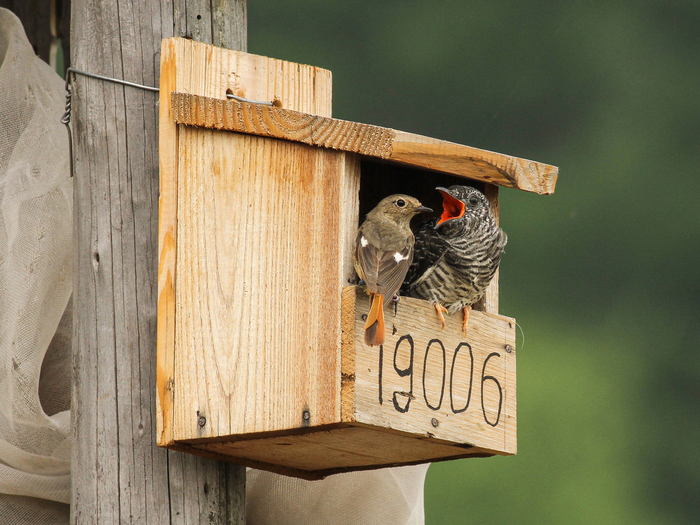Daurian redstarts move their nesting sites closer to or even inside human settlements when cuckoos are around. In doing so, they actively protect their nest against brood parasitism, as cuckoos avoid human settlements. An international team of scientists showed both observational and experimental evidence for this anti-parasitism strategy in a population of Daurian redstarts in northeastern China. Their research illustrates how the breeding behavior of two interacting bird species co-evolves. It also gives us a glimpse on how urbanization can affect interspecific interactions.

Credit: Max Planck Institute for Biological Intelligence / Jinggang Zhang
Daurian redstarts move their nesting sites closer to or even inside human settlements when cuckoos are around. In doing so, they actively protect their nest against brood parasitism, as cuckoos avoid human settlements. An international team of scientists showed both observational and experimental evidence for this anti-parasitism strategy in a population of Daurian redstarts in northeastern China. Their research illustrates how the breeding behavior of two interacting bird species co-evolves. It also gives us a glimpse on how urbanization can affect interspecific interactions.
Cuckoos lay their eggs into other birds’ nests, using their hosts’ breeding efforts for their own reproduction. The ‘foster parents’ invest resources in raising another bird’s offspring, at the expense of their own young. This strategy is called brood parasitism and takes a heavy toll on the exploited species. The female cuckoo usually removes one or more host eggs before parasitizing the nest and cuckoo chicks typically evict all host offspring from the nest to monopolize parental care. It is thus in the breeding adults’ best interest to be able to detect the cuckoo egg and remove it from their nest. However, potential hosts can also use tactics to avoid getting parasitized in the first place.
Scientists from the Max Planck Institute for Biological Intelligence and colleagues from Beijing Normal University and Beijing Forestry University in China now observed a remarkable example of adaptive nest site choice in the Daurian redstart. The passerine bird is a common host for cuckoos in northeastern China. Daurian redstarts breed twice per season – once before and once after cuckoos arrive in the region. Cuckoos generally avoid close contact with humans.
The researchers found that redstarts moved their nests closer to human settlements in the second egg-laying period, presumably to keep the cuckoos away. The scientists were then able to elicit the same behavior during the first egg-laying period by presenting cuckoo models and playing back cuckoo calls to mimic the presence of the brood parasite.
“We were able to show experimentally for the first time that Daurian redstarts adapt their nesting behavior depending on whether they notice cuckoos in the area,” says Jinggang Zhang, postdoctoral researcher in the department of Bart Kempenaers at the Max Planck Institute for Biological Intelligence. The simulated presence of cuckoos caused the redstarts to move their nests closer to buildings or even to breed indoors. This matches their natural behavior during the second egg-laying period, when cuckoos are actually present.
The scientists also found that the risk of becoming a host for a cuckoo egg increases with the distance between the nest and the nearest human settlement. Daurian redstarts have thus developed a novel strategy to use human settlements to their own advantage. These observations raise an important question: how are cuckoos coping with the ongoing expansion of urban areas?
“Urbanization affects habitats and animal populations around the world in many ways. Cuckoos may have to adapt to this development by venturing closer to human settlements as well, or by expanding the range of host species,” says Bart Kempenaers, director at the institute.
Finding solutions to new problems is a hallmark of evolution, and cuckoos have demonstrated their problem-solving skills before. In a second study, the scientists monitored the cuckoos’ strategy in choosing a suitable nest. Redstart eggs come in two different colors – in a shade of blue and pink, respectively. Cuckoo eggs are blue and a cuckoo female would benefit from laying her eggs in host nests with blue eggs if the parasitic egg then has a higher chance of being accepted by the host.
“This egg matching strategy has been postulated before, but the studies that were conducted so far have not provided experimental evidence for its existence,” explains Jinggang Zhang. Over five years, the researchers therefore monitored more than 500 redstart nests for signs of parasitism. Indeed, the nests that contained blue eggs were more than twice as likely to be selected by cuckoos.
The scientists also set up artificial nests with blue or pink redstart eggs near the active nests. In nearly all cases, the cuckoos chose nests that contained blue eggs – and they even preferred dummy nests with blue eggs over nearby active nests with pink eggs.
“We were surprised to find such a clear preference for nests with blue eggs. Our observations suggest that cuckoo females are quite sensitive to characteristics of the nest and not just dump their eggs in any host nest they can find,” says Bart Kempenaers.
Journal
Current Biology
DOI
10.1016/j.cub.2023.01.047
Method of Research
Observational study
Subject of Research
Animals
Article Title
Brood parasitism risk drives birds to breed near humans
Article Publication Date
17-Feb-2023




